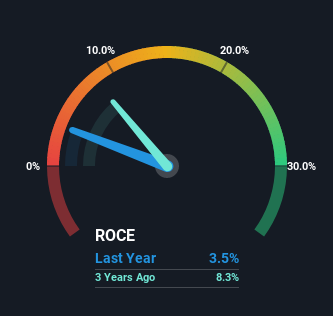- United States
- /
- Metals and Mining
- /
- NYSE:CRS
Some Investors May Be Worried About Carpenter Technology's (NYSE:CRS) Returns On Capital

To avoid investing in a business that's in decline, there's a few financial metrics that can provide early indications of aging. Typically, we'll see the trend of both return on capital employed (ROCE) declining and this usually coincides with a decreasing amount of capital employed. Basically the company is earning less on its investments and it is also reducing its total assets. And from a first read, things don't look too good at Carpenter Technology (NYSE:CRS), so let's see why.
Return On Capital Employed (ROCE): What Is It?
Just to clarify if you're unsure, ROCE is a metric for evaluating how much pre-tax income (in percentage terms) a company earns on the capital invested in its business. The formula for this calculation on Carpenter Technology is:
Return on Capital Employed = Earnings Before Interest and Tax (EBIT) ÷ (Total Assets - Current Liabilities)
0.035 = US$88m ÷ (US$3.1b - US$544m) (Based on the trailing twelve months to March 2023).
Thus, Carpenter Technology has an ROCE of 3.5%. Ultimately, that's a low return and it under-performs the Metals and Mining industry average of 12%.
See our latest analysis for Carpenter Technology

In the above chart we have measured Carpenter Technology's prior ROCE against its prior performance, but the future is arguably more important. If you'd like to see what analysts are forecasting going forward, you should check out our free report for Carpenter Technology.
SWOT Analysis for Carpenter Technology
- Debt is well covered by .
- Interest payments on debt are not well covered.
- Dividend is low compared to the top 25% of dividend payers in the Metals and Mining market.
- Expensive based on P/E ratio and estimated fair value.
- Annual earnings are forecast to grow faster than the American market.
- Debt is not well covered by operating cash flow.
- Dividends are not covered by earnings.
- Revenue is forecast to grow slower than 20% per year.
What The Trend Of ROCE Can Tell Us
There is reason to be cautious about Carpenter Technology, given the returns are trending downwards. To be more specific, the ROCE was 6.8% five years ago, but since then it has dropped noticeably. On top of that, it's worth noting that the amount of capital employed within the business has remained relatively steady. Since returns are falling and the business has the same amount of assets employed, this can suggest it's a mature business that hasn't had much growth in the last five years. So because these trends aren't typically conducive to creating a multi-bagger, we wouldn't hold our breath on Carpenter Technology becoming one if things continue as they have.
The Bottom Line On Carpenter Technology's ROCE
In summary, it's unfortunate that Carpenter Technology is generating lower returns from the same amount of capital. Despite the concerning underlying trends, the stock has actually gained 2.4% over the last five years, so it might be that the investors are expecting the trends to reverse. Regardless, we don't like the trends as they are and if they persist, we think you might find better investments elsewhere.
Carpenter Technology does have some risks though, and we've spotted 1 warning sign for Carpenter Technology that you might be interested in.
While Carpenter Technology may not currently earn the highest returns, we've compiled a list of companies that currently earn more than 25% return on equity. Check out this free list here.
New: AI Stock Screener & Alerts
Our new AI Stock Screener scans the market every day to uncover opportunities.
• Dividend Powerhouses (3%+ Yield)
• Undervalued Small Caps with Insider Buying
• High growth Tech and AI Companies
Or build your own from over 50 metrics.
Have feedback on this article? Concerned about the content? Get in touch with us directly. Alternatively, email editorial-team (at) simplywallst.com.
This article by Simply Wall St is general in nature. We provide commentary based on historical data and analyst forecasts only using an unbiased methodology and our articles are not intended to be financial advice. It does not constitute a recommendation to buy or sell any stock, and does not take account of your objectives, or your financial situation. We aim to bring you long-term focused analysis driven by fundamental data. Note that our analysis may not factor in the latest price-sensitive company announcements or qualitative material. Simply Wall St has no position in any stocks mentioned.
About NYSE:CRS
Carpenter Technology
Engages in the manufacture, fabrication, and distribution of specialty metals in the United States, Europe, the Asia Pacific, Mexico, Canada, and internationally.
Excellent balance sheet with proven track record.


